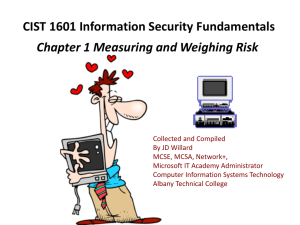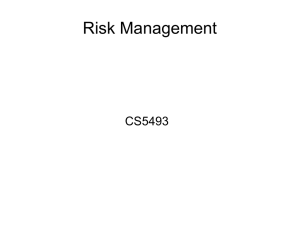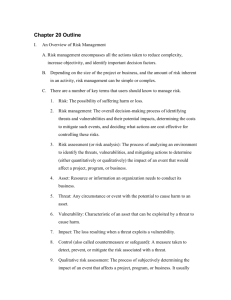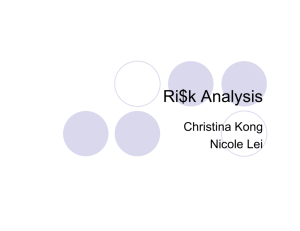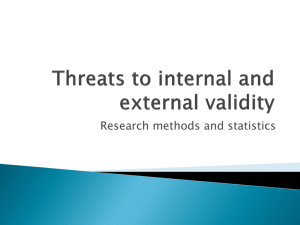CBK Domain #1 Information Security and Risk Management
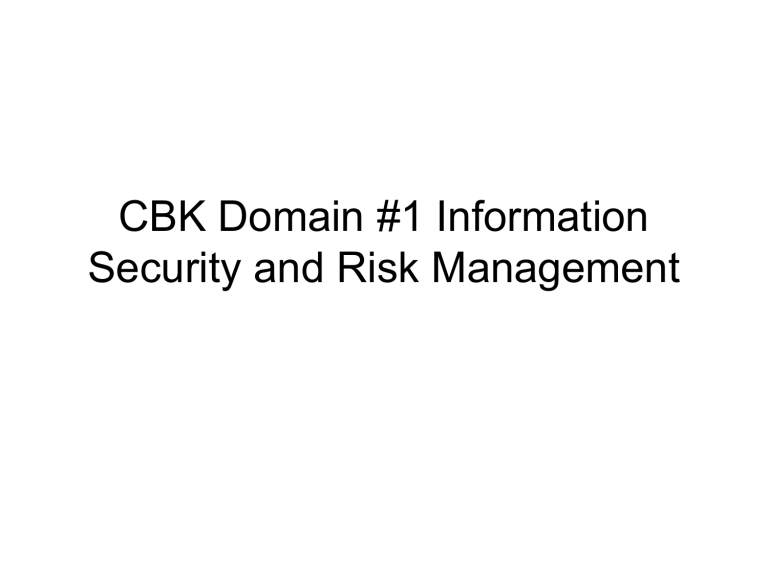
CBK Domain #1 Information
Security and Risk Management
Chapter 1 – we will talk about
• The CIA triad (out of order)
• Security Management Responsibilities
• Administrative, Technical and Physical
Controls
• Risk Management and Risk Analysis
• Security Policies
• Information Classification
• Positions and Responsibilities
CIA, it’s not just a government agency (59)
• The CIA triad provides for the security objectives. This is also called the AIC triad.
Confidentiality (60)
• Protects the data from un-authorized disclosure
• Ensures the necessary level of secrecy is enforced at each junction of data processing
• Can provide via technical controls such as authentication methods, encryption methods
• Attacks include shoulder surfing and social engineering, man in the middle, attempts at decryption. etc
Integrity (60)
• Ensuring that the data is not modified.
• Must ensure accuracy and reliability of the information and Information Systems.
Must not allow unauthorized modification.
(either intentional or accidental*)
Integrity Example
• The trader was supposed to sell one share for
610,000 yen ($5,065). Instead, 610,000 shares valued at $3.1 billion were offered for 1 yen each.
• Somebody made a typing mistake, said the brokerage unit of Mizuho Financial Group,
Japan's second-largest bank. The error set off a frenzy of trades, and cost the unit at least 27 billion yen ($224 million) as it tried to buy back the shares, the bank said.
Integrity
• Hashes and signed messages are examples of how to ensure integrity
• Can attack with birthday attacks / hash collisions. Man in the middle attacks
Availability
• The ability to access data and systems by authorized parties
• This is very easy to attack and hard to defend against.
• Attacks are often DoS type attacks.
• Example of Availability attack:
– Taking down a power grid
– Stopping stock market trades
Security Management
Now that we know the 3 principles of security lets talk about how we can manage security
Security Management (back to pg 53)
Attempts to manage security.
• Includes Risk Management, IS Policies, Procedures,
Standards, Guidelines, Baselines, Information
Classification, Security Organization. *
• These build a security program – Purpose… protect the companies assets
• A security program requires balanced application of
Technical and non-technical methods!*
• Process is circular, asses risks, determine needs, monitor, evaluate… start all over.
Security Management
• Management is ULTIMATELY responsible for security… NOT admins, not security workers.. MANAGEMENT… let me repeat… MANAGEMENT.
• Management must lead and direct all security programs. They must provide the vision AND support*
Security Management
• Any good security program should be “top down” with an ultimate goal. This approach management creates the vision and lays out the framework. It does not make sense just to run about locking down machines without a vision.
Though this is often how things are actually done.*
• Why would a bottom up approach fail? (can you build a house by just starting to build?)
IMPORTANT REMINDER
• Reminder MANAGEMENT should direct security. A security officer or groups is to ensure the managements directives are fulfilled! They do NOT create security policy*
Security Controls
The following “controls” should be utilized to achieve security management directives
• Administrative – policies, standards, procedures, guidelines, personnel screening, training
• Technical Controls (logical controls)* authentication, firewalls, biometrics etc.
• Physical Controls – locks, monitoring, mantraps, environmental controls.
• See diagram on page 57
Functional vs. Assurance
• All solutions must be evaluated by it’s functional and assurance requirements
• Functional: “Does the solution carry out the required tasks”*
• Assurance: “How sure are we of the level of protection this solution provides”*
Security Definitions*
• You need to know these!
• These terms are on pages 61-63. You should all memorize and internalize these terms! Read them again and again till you understand them.. We’ll cover them in the next couple slides
Vulnerability* (61)
• A software hardware or procedural weakness that may provide an attacker the opportunity to obtain unauthorized access.
– Could be an un-patched application
– Open modems
– Lax physical security
– Weak protocol* (let’s define protocol)
Threat *
A natural or man-made event that could have some type of negative impact on the organization.
• A threat usually requires a vulnerability
• A threat might also be natural such as a hurricane
Threat Agent
• An actual person that takes advantage of a vulnerability
Risk
This likelihood of a threat agent taking advantage of a vulnerability and the corresponding business impact
• Risk ties the vulnerability, threat and likelihood of exploitation together.
Exposure
An instance of being exposed to losses from a threat agent.
• Example: A public web server that has a known vulnerability that is not patched, is an exposure.
Countermeasure or Safeguard
Some control or countermeasure put into place to mitigate the potential risk. A countermeasure reduces the possibility that a threat agent will be able to exploit a vulnerability. (You can NEVER 100% safeguard something)*
End of risk terms
Organizational Security Models
• Each organization will create it’s own security model which will have many entities, protection mechanisms, logical, administrative and physical components, procedures, business processes and configurations that all support the end goal.
• A model is a framework made up of many entities protection mechanisms, processes, procedures that all work together and rely on each other to protect the company (see diagram pg 65)
(more)
Organization Security Models
• Each company will have it’s own methods for the above to accomplish their own security model.
• Has multiple layers and Multiple GOALS
(talk about next)
Goals*
• Operational goal – These are DAILY goals, very short term goals.
– Example: installs security patch released today.
• Tactical goals – mid term goals that help to achieve a final goal.
– Example: create managed domain and move all workstations into the domain
• Strategic Goals – long term objectives.
– Example: Have all workstations in a domain with centralized security management, auditing, encrypted data access and PKI.
Security Program Development (pg
76 in book)
• A program is more than just a policy! It’s everything that protects data.
• Security Program development is a
LIFECYCLE!!!
– Plan and Organize
– Implement
– Operate and Maintain
– Monitor and Evaluate
– Then start all over again!
Business Requirements Private vs.
Military
• Which security model an organization uses depends on it’s goals and objectives.
– Military is generally concerned with
CONFIDENTIALITY
– Private business is generally concerned with either availability (ex. Netflix, eBay etc) OR integrity (ex. Banks). Some private sector companies are concerned with confidentiality
(ex. Drug companies)
Break?
• This is probably time for a break… you probably are asleep now… don’t worry it will get more interesting in a bit.
Information Risk Management
• IRM is the process of identifying and assessing risk and reducing it to an acceptable level*
• There is no such thing as 100% security!*
• You must identify risks and mitigate them with either countermeasure (ex. Firewalls) or by transferring risk (ex. Insurance)*
What are risks*
• Physical Damage – building burns down
• Human Interaction – accidental or intentional action
• Equipment malfunction – Failure of systems (hard drives failure)
• Inside and Outsides attacks – CRACKERS! (not hackers)
• Misuse of Data – Sharing Trade secrets, fraud
• Loss of Data – intentional or unintentional loss of data
• Application Error – (integrity) computation errors, input errors, poor code/bugs. (superman/office space example)
Risks
• Risks MUST be identified, classified and analyzed to asses potential damage (loss) to company. Risk is impossible to totally measure, but we must prioritize the risks and attempt to address them!
Risk management
• Did I mention that IRM is ULTIMATELY the responsibility of MANAGEMENT* (I really cannot stress this enough)
• Should support the organizations mission.
• Should have an IRM policy.
• Should have an IRM team.
• IRM should be a subset of the companies total Risk Management Policy.
IRM policy
Should include the following items
• (see top of page 82)
• Goal if IRM is to ensure the company is protected in the most COST EFFECTIVE manner!* (doesn’t make sense to spend more to protect something than the
“something” is worth)
IRM team (83)
• Remember goal is to keep things cost effective.
Many companies will not have a large IRM team.
Government might have small armies dedicated simply to IRM goals.
• IRM team members usually have other full time jobs!
• Not just IT staff! (ex IT staff may not understand legal or physical concerns)
• Senior Management Support is NECESSARY for success*
Risk Analysis (83)
IRM team will need to analyze risk, what is risk analysis?
– A tool for risk management, which identifies assets, vulnerabilities and threats (What are these again?)
– Access possible damage and determine where to implement safeguards
We will talk about RA goals next.
Risk Analysis Goals (83)
• Identify assets and their values
• Identify Vulnerabilities and threats
• Quantify the probability of damage and cost of damage
• Implement cost effective countermeasures!
• ULTIMATE GOAL is to be cost effective . That is: ensure that your assets are safe, at the same time don’t spend more to protect something than it’s worth*
who is ultimately responsible for risk?
• MANAGEMENT!
• Management may delegate to data custodians or business units that shoulder some of the risk. However ultimately it is senior management that is responsible for the companies health and as such they are ultimately responsible for the risk. (you really need to understand this for the exam)
Value of information and assets?
(85)
It is important to understand an assets value if you plan on doing risk analysis. So what is something worth?
– See pg 86 bullet items
Note value can be measured both quantitatively and qualitatively*
2 types of analysis
• Quantitative analysis
• Qualitative analysis
Lets talk in detail about Qualitative vs.
Quantitative specifically in the next couple slides
Quantitative (92)
Quantitative analysis attempts to assign real values to all elements of the risk analysis process. Including
• Asset value
• Safeguards' costs
• Threat frequency
• Probability of incident
(more)
Quantitative Analysis (93)
• Purely quantitative risk analysis is impossible as there are always unknown values, and there are always “qualitative” values. (what is the value of a reputation?)
• You can automate quantitative analysis with software and tools. These require tons of data to be collected though, as such require along time and effort to complete, but the tools help speed that up.
Overview of steps in a quantitative analysis (94)
1. Assign value to an asset
2. Estimate actual cost for each asset and threat combination. (see SLE later)
3. Perform a threat analysis – determine the probability of each threat occurring.
4. Derive the Overall loss potential per threat per year.
5. Reduce, Transfer Avoid or Accept the
Risk.
Steps in Quantitative Analysis (94)
Now lets’ break each step out more
Step 1:Assign value to assets (94)
What is something worth?
• Cost to obtain
• Money an asset brings in
• Value to competitors
• Cost to re-create
• Legal liabilities
Step 2:Estimate Loss Potential*
(94)
For Each threat we need to determine how much could a threat damage/cost us
• Physical damage
• Loss of productivity
• Cost of repairing
• Amount of Damage (EF – next slide)*
We need to determine “Single Loss Expectancy” per asset and threat*
• Example: if you have a virus outbreak and each outbreak costs $50K in lost revenue and repair costs. Your SLE = 50K
Step 2: Estimate of Loss potential
When determining SLE, you may hear the term EF
(exposure factor)
For some items loss is a percentage of a value, this is where EF comes in
If you have a warehouse with $1,000,000 of value, and the threat is a fires, your fire suppression systems might stop a fire at 25%, this is your EF, and must be calculated in SLE
SLE= total value/cost * EF
In this case the fire SLE = $1,000,000 * .25 =
$250,000
Step 3:Perform a Threat Analysis
(95)
Figure out the likely hood of an incident.
• Analyze vulnerabilities and rate of exploits.
• Analyze probabilities of natural disasters to your location
• Review old records of incidents.
In this step we need to calculate the Annualized
Rate of Occurrence (ARO)*
Example: chance of a virus outbreak in any month=75% then the ARO = .75 * 12 (1 year) So we can expect an ARO=9
Step 4: Derive the ALE (95)
Derive the Annual Loss Expectancy
• SLE * ARO = ALE
• Example: 50K cost of virus outbreak (SLE)
* 9 occurrences per year (ARO) = $450K cost for this threat
• Be able to do these calculation for the exam
Step 5: Reduce, Transfer, Avoid or
Accept the Risk (95)
For each risk you can do the following
• Reduce risk* (install countermeasures to lessen the risk, or mitigate EF (exposure factor) (well go in depth on next slide)
• Transfer Risk* (buy insurance)
• Accept Risk* (do nothing to minimizing risk)
• Avoid Risk (stop doing activity that causes risk)*
Details of Reducing Risk (102)
When determining whether to implement an countermeasure, you MUST be concerned about being cost effective* It makes no sense to spend more to protect an asset then it’s worth! Understand this!*
How do we determine whether it’s worth it…
MATH! (next slide)
Details of Reducing Risk (102)
If the cost per year of the countermeasure is more than the ALE, don’t implement it. (or do something else like buy insurance)
Let’s each do the handout word problem by ourselves and discuss in 5 minutes.
Word Problem
• The probability of a virus infection per month is 50%.
• If an outbreak occurred your sales staff of 5, would not be able to work for the 4 hours while the systems were rebuilt. Each sales person makes $40/hour.
• IT would require 1 person 4 hours to repair at a cost of
$50/hour.
• A certain antivirus system could stop ALL viruses (ok, that’s just to make the math easier) but the cost is 20K per year for this system.
• Should you implement the Anti-virus system?
• If so how much are you saving?
• If not how much are you wasting by buying it?
Word Problem Answer
Determine SLE
(5 sales * 4 hours each * $40) + (1 IT * 4 hours *
50) = $1000 cost per incident
ARO = 12 months * .50 likelihood per month= 6
ALE = SLE ($1000) * ARO (6) = $6000.00
Cost to protect = $20,0000.00 a year
No it costs more to protect than it’s worth.
If you bought the AV system, you’d waste $14,000 a year.
Total Risk vs. Residual Risk (106)
• No matter what controls you place to protect an asset, it will never be 100% secure. The leftover risk after applying countermeasures is called the residual risk .*
• Total Risk is the risk a company faces if they choose not to implement a safegaurd
(if the accept the risk)
(more)
Total Risk vs. Residual Risk (106)
A control gap* is the protection a countermeasure cannot provide
Conceptual (not actual) formulas*
• Threats x vulnerabilites x asset value = total risk
Or
• (threats, vulnerabilities, asset value = total risk
• (threats x vuln x asset value) x control gap = residual risk
Or
• Total risk – countermeasures = residual risk
Review of Quantitative (back to 95)
• Assign value to assets
• Estimate potential Loss per Threat (SLE)
• Estimate likelihood of threat
• Estimate Annual Loss per year (ALE)
• Reduce, Transfer, Avoid or Accept Risk
Qualitative Risk Analysis
Rather than assign values to everything, walk through different scenarios and rank the seriousness (prioritize) based on threats and counter measures
Techniques includes
• Judgment
• Best practices
• Intuition
• Experience
(more)
Qualitative (98)
Specific techniques include
• Delphi (later)
• Brainstorming
• Storyboarding
• Focus groups
• Surveys
• Questioners
• Interviews and one-on-one meetings
Delphi* (100)
Technique where a groups comes together, each member gives an honest opinion of what he or she believes the result of a threat will be. Idea is to have everyone express their true ideas and not just go along with one person dictates
The results are then compiles and given to group members that ANONYMOUSLY write down there comments and returned to analysis group.
These comments are compiled and redistributed for comments until a consensus is reached
Modified Delphi
A silent form of brainstorming , participants develop idea individually without a group and submit their ideas to decision makers.
Review of Quantitative and
Qualitative (101)
Read over chart on 101 – internalize for exam
Qualitative Cons –
• Subjective
• No dollar values
• No standards
(more)
Review of Q vs. Q
Quantitative cons
• Complex calculations
• Extremely difficult without tools
• Lots of preliminary work required
Policies Standards, Baselines,
Guidelines and Procedures (109)
A security program must have all the pieces necessary to provide overall protection to a company and lay out a long term strategy.
Policies, Standards, Baselines, Guidelines and
Procedures are part of the security program
You NEED to understand the terms in the following slides for the exam. (Polices, standards, baseline, guidelines and proceedures)
Security Policy* (110)
An overall GENERAL statement provided by senior management.
• Very generic
• Provides “missions statement for security”
• Should represent business objectives
• Should be easily understood
• It should be developed at integrate security into
ALL business functions and processes*
(more)
Security Policy (110)
• It should be reviewed an modified as a company changes.
• Policy should be dated and version controlled.
• It should be forward thinking
• It should use strong language (MUST, not should)
• Should be non-technical
(more)
Security Policy
Can be one of three types
• Regulatory – ensures an organization is following required regulations (finance, health)
• Advisory – strongly advises employees as to which types of behaviors should/should not take place
• Informative – informs employees of goals and missions relevant to a company, not specific or enforceable
Standards* (112)
Standards are MANDATORY* actions or rules. Defines compulsory* rules.
Standards give a policy it’s support and start adding specifics.
• Example: a standard is “all employees
MUST wear their company ID badge at all times”
Baseline* (113)
Baselines (in regards to policy) are minimum levels of protection required.
For example: a baseline my require that a system be compliant to some external measurement. Any systems must meet these requirements, changes to the system must be assessed to ensure the baseline is still being met.
(more)
Baseline
A baseline may also be a technical definition or configuration of a system.
• Example: a baseline my specify that all windows XP systems must have SP2 installed, and ISS turned off.
• Example: a baseline may also specify all
Linux systems run SElinux in enforcing mode.
Guidelines* (114)
Guidelines are RECOMMENDED actions.
These cover the gray areas and are approaches to provide flexibility for unforeseen things. (not every situation can be pre-known)
• Can anyone give me an example of a guideline?
Procedures* (114)
Detailed step-by-step tasks that should be performed in some situation.
• Example: written procedures on OS installation and configuration.
• Lowest level In the policy as they are closest to users and resources.
• Procedures spell out how policy, standards and guidelines will be implemented for a specific resources (ex. OS)
Random Terminology*
• You need to understand these 2 terms for the exam
• Due Diligence*: act of investigating and understanding a risk a company faces.
• Due Care*: demonstrates that a company has taken responsibility for it’s activities and has taken necessary steps to protect it’s assets and employees from threats.
Not practicing these can lead to charges of negligence.
Review of Policies, Standards…
We just talked about Polices, Standards,
Baselines, Guidelines and Procedures
• Everyone remember what they all are?
• Internalize these terms for the exam
Information Classification (117)
We need to be able to assign value to information. Especially where secrecy is concerned. (both military and private sector)
Data is classified to ensure data is protected in a COST-EFFECTIVE* manner.
Each classification should have separate handing requirements.
(more)
Information Classification
Military vs. private sector concerns
• Military is usually more concerned with confidentiality
• Private Sector is usually more concerned with integrity and availability
What are some common classifications?
Let’s look in the book at page 118.
You should know these levels and what are example of each level for the exam!
Classification Controls
Once data is classified we have some actions we should take to protect and manage the data
• Access controls
• Encryption of data in transit* and at rest* (what are these terms)
• Data access should be logged and audited
• Periodically review classifications
(more)
Classification Controls
• Backup and restoration procedures
• Change Control procedures
• Proper data disposals
Positions and Responsibilities
Senior management is obviously
ULTIMATELY responsible for data security, risk management and pretty much everything else. However let’s look at some of the other positions commonly found and see what their responsibilities are.
• For the exam, you should know all the positions we are about to talk about*
Data Owner* (130)
Data owner is usually a member of management who is in charge of a specific business unit and responsible for that information that such a unit possesses.
• Responsible for specifying the classification of data
• Responsible for determining necessary controls are in place to protect data
(more)
Data Owner*
• Defining backup requirements (not implementing)
• Determines who gets access to data (in a
DAC model)
• Delegates day-to-day maintenance to the
“data custodian”
• This is a “Business” role
Data Custodian* (131)
The Data Custodian MAINTAINS the data day to day.
• Performs backups
• Validates data integrity
• Restores data
System Owner (131)
System owner is responsible for one or more systems that hold and process data.
• Responsible for integrating security considerations into application and system purchasing.
• Responsible to ensure adequate security is being provides by the necessary controls
(passwords, remote access, OS configurations)
• Must ensure systems are assessed for vulnerabilities and must report any to the incident response team and DATA OWNER.
Security Administrator* (132)
Setup security configurations on a system as defined by the DATA OWNER*
• Does not authorize permissions for a user, that’s the data owners responsibility*, just configures security settings based the what is set down by the data owner*
• Creates accounts
• Sets access rights in support of the policies defined.
• Technical position.
Security Analyst* (132)
Helps define a security program elements and ensures the elements are being implemented properly by the technical people and procedures.
• This is NOT an implementation role
• Higher more strategic level.
Application Owner* (132)
This is like a data owner, but in regards to applications.
• Usually business unit managers.
• Responsible for determine who may have access to their applications. (in lines of company policy)
• Responsible for the security of a units applications. Ensuring testing, patching and proper change control is implemented. (though they do not themselves do this work)
Supervisor (132)
More of an HR role, you all know what a supervisor does.
• Managing employees
• Ensuring employees live up to their responsibilities
• Handle HR tasks such as hiring, firing and initiating corrective action.
• Informing security admin of changes to an employees position.
Data Analyst (133)
Ensures hat data is stored in a way that makes the most sense for it’s application.
• Specifically considered with information
“architecture”, how data is stored in reference to other data, data structures
• Work with data owners to ensure the structures support the business objectives.
Process Owner (133)
Are responsible for certain business processes (not computer processes ;)
• An example of a process is procurement
• Another example is Hiring
• Another example is order fulfillment
Solution Provider
These are vendors… enough said
User * (134)
Someone who uses the data, day to day to accomplish work tasks and business objectives
• Responsible for following data and security procedures that have been laid out by management.
Auditor* (134)
Provides a method for independently ensuring that management and shareholders can rely upon the appropriateness of security objectives.
• Determines if controls/methods have been reached
• Determines if practices are in compliance with company or legal requirements
• Should be 3 rd party
(more)
Auditor (not in book)
The exam might also refer to an auditor in the role of someone in the company that goes though security, or usage logs to determine if data and technical systems are being used/abused/attacked etc.
• This is the form/usage I remember from the exam.
Enough of the positions
Lets talk abut Employee type concerns and techniques.
Separation of Duties*
The idea of ensuring one individual cannot complete a critical task by themselves.
• Reduces the possibility for fraud, sabotages, theft or general abuse.
• Separation of Duties requires Collusion*
(next page) for the above problems to occur
Collusion* (136)
Means that at least two people must WORK
TOGETHER to pull off some type of negative action.
• For the exam. Read pg 136 (let’s do this together) regarding software development.. You will probably see this or similar concepts, we will also talk abut this later
Hiring Practices* (136)
• All employees should have background checks and be screened* (even janitors etc in high security environments)
• Everyone MUST sign an NDA, which should protect secrets and conflicts of interest.
• Drugs tests
• Education checks
• Reference checks
Rotation of Duties* (138)
Employees should rotate in their duties
Why?
• For redundancy
• To ensure no-one has too much control over a segment of business
Mandatory Vacations* (139)
Employees MUST take vacations
Why?
• Gives opportunity for others to discover fraud. If employees don’t want to take a vacation, they might be doing something underhanded and don’t want to be found out
• Also enforces that other people can step in and that the process cannot be disrupted by that employee being absent for whatever reason.
Split Knowledge* (138)
Separation of duties concept. Where someone only has enough knowledge to perform part of a task. Again helps fight fraud.
• Example: two manager only know half a bank vault combination.
Dual Control
Like split knowledge, but in this case two or more people must be available and active to perform an action.
• Example two physically separated locks to a vault that must be turned at the same time.
Employee Termination*
Companies should have a strict procedure for employee termination, can be different for each company, but must be strictly enforced.
Examples policy is
• Employee must leave the facility immediately under supervision of a security guard
• Employee must surrender id badges, keys
• Employee must complete an exit interview
• Employee accounts must be locked out.
OK chapter review
We covered a lot.
Let’s look over the quick tips and questions.



